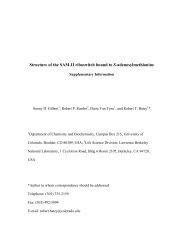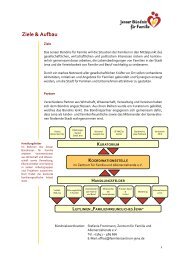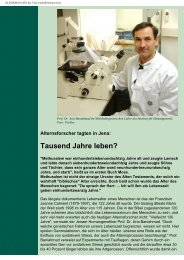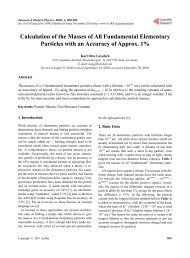Ligand-based Design - Leibniz Institute for Age Research
Ligand-based Design - Leibniz Institute for Age Research
Ligand-based Design - Leibniz Institute for Age Research
Create successful ePaper yourself
Turn your PDF publications into a flip-book with our unique Google optimized e-Paper software.
<strong>Ligand</strong> <strong>Ligand</strong>-<strong>based</strong> <strong>based</strong> <strong>Design</strong>: 3D 3D-QSAR QSAR CoMFA<br />
Partial least squares regression (PLS regression) is a statistical method that finds a linear regression model by<br />
projecting the predicted variables and the observable variables to a new space. Because both the X and Y data are<br />
projected to new spaces, spaces the PLS family of methods are known as bilinear factor models. models<br />
PLS is used to find the fundamental relations between two matrices (X and Y), i.e. a latent variable approach to<br />
modeling the covariance structures in these two spaces. A PLS model will try to find the multidimensional direction<br />
in the X space that explains the maximum multidimensional variance direction in the Y space space. PLS‐regression is<br />
particularly suited when the matrix of predictors has more variables than observations, and when there<br />
is multicollinearity among X values. By contrast, standard regression will fail in these cases.<br />
PLS regression is an important step in PLS path analysis analysis, a multivariate data analysis technique that employs latent<br />
variables. This technique is often referred to as a <strong>for</strong>m of variance‐<strong>based</strong> or component‐<strong>based</strong> structural equation<br />
modeling.<br />
Partial least squares was introduced by the Swedish statistician Herman Wold Wold, who then developed it with his son son,<br />
Svante Wold, a professor of chemometrics at Umeå University. An alternative term <strong>for</strong> PLS (and more correct<br />
according to Svante Wold [3] ) is projection to latent structures, but the term partial least squares is still dominant in<br />
many areas. It is widely applied in the field of chemometrics, in sensory evaluation, and more recently, in the analysis<br />
of functional brain imaging data [4]<br />
of functional brain imaging data.














![Programm [pdf]](https://img.yumpu.com/20944039/1/184x260/programm-pdf.jpg?quality=85)

